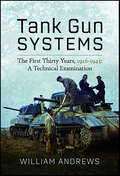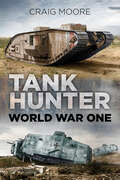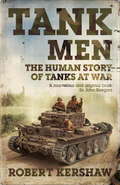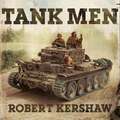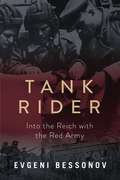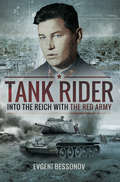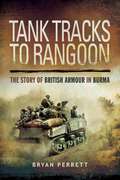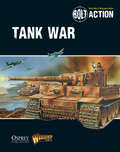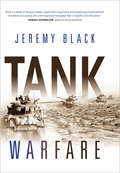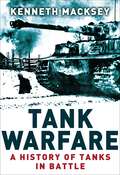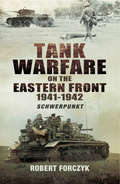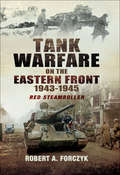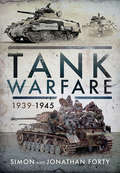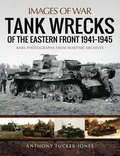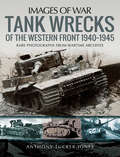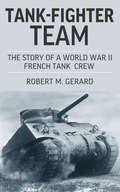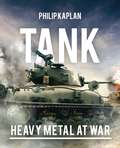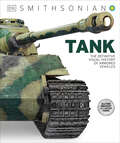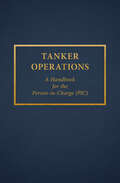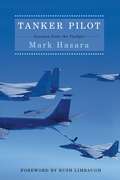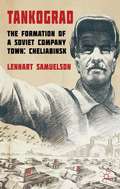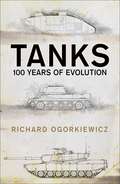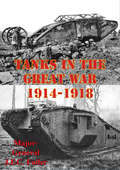- Table View
- List View
Tank Gun Systems: The First Thirty Years, 1916–1945: A Technical Examination
by William AndrewsMuch has been written about the use of tanks in battle. Little, however, has appeared about the gunnery systems that are at their core. This book describes and examines the main gun systems of medium and heavy tanks from first use in 1916 in World War I to those fielded in numbers to the end of World War II in 1945, including tanks of the interwar period. Specifically considered are guns of a caliber greater than 35 mm, which have been deployed in numbers greater than 100. The emphasis is on guns mounted in turrets on heavier tracked armored fighting vehicles (greater than 15 tonnes) which were considered tanks. There are, though, exceptions, in that the naval 6 pounder guns in First World War British tanks, as well as the 75 mm guns in French medium tanks of the same period (all turretless) are included. The treatment of gun systems includes sighting and fire control equipment, gun laying equipment, mounts and the array of munitions fired, as well as the actual gun, including its, barrel, cradle, breech, firing mechanism, sights and recoil system. Related to this are issues of gun handling (loading and unloading), ammunition design and rates of fire. Also examined are the maximum impulse and energy generated by firing some of the munitions available that must be absorbed by the gun recoil system.
Tank Hunter: World War One
by Craig MooreThe new Tank Hunter World War One book covers all the British and French built tanks used by US tank crews in the Great War of 1914-1918. There are sections of the book devoted to early American tank development including the Skeleton tank, US Steam Tank (Track Laying), Holt Gas-Electric Tank, Ford 3-ton tank and the M1917 6-ton tank. There is also information on the four tank battles fought by the 301st Battalion, US Tank Corps in 1918.
Tank Men
by Robert Kershaw'I thought Tank Men was a triumph ...it is a really fine piece of work' - Richard Holmes'Some of the eye witness accounts Kershaw has collected for this comprehensive review of tank warfare have the power to chill the reader to the bone. This is warfare at the sharp end' --NOTTINGHAM EVENING POSTThe First World War saw the birth of an extraordinary fighting machine that has fascinated three generations: the tank. In Tank Men, ex-soldier and military historian Robert Kershaw brings to life the grime, the grease and the fury of a tank battle through the voices of ordinary men and women who lived and fought in those fearsome machines. Drawing on vivid, newly researched personal testimony from the crucial battles of the First and Second World Wars, this is military history at its very best.
Tank Men (Hachette Military Collection)
by Robert KershawThe First World War saw the birth of an extraordinary fighting machine that has held an enduring fascination for over a century: the tank. In TANK MEN, ex-soldier and military historian Robert Kershaw brings to life the grime, the grease and the fury of a tank battle through the voices of ordinary men and women who lived and fought in those fearsome machines. Drawing on vivid personal testimony from the crucial battles of the First and Second World Wars, this is military history at its very best.
Tank Men: The Human Story Of Tanks At War (Hachette Military Collec Ser.)
by Robert Kershaw'I thought Tank Men was a triumph ...it is a really fine piece of work' - Richard Holmes 'Some of the eye witness accounts Kershaw has collected for this comprehensive review of tank warfare have the power to chill the reader to the bone. This is warfare at the sharp end' --NOTTINGHAM EVENING POST The First World War saw the birth of an extraordinary fighting machine that has fascinated three generations: the tank. In Tank Men, ex-soldier and military historian Robert Kershaw brings to life the grime, the grease and the fury of a tank battle through the voices of ordinary men and women who lived and fought in those fearsome machines. Drawing on vivid, newly researched personal testimony from the crucial battles of the First and Second World Wars, this is military history at its very best.
Tank Rider: Into the Reich with the Red Army
by Evgeni BessonovA sobering account of conflict on the Eastern Front of World War II told from the perspective of a Russian soldier.Honest and irrepressibly frank, these are the dramatic memoirs of a Russian officer on the Eastern Front, where he played his part in a clash of titans and witnessed the shuddering collapse of the Third Reich.The cataclysmic battle of Kursk in 1943 put an end to Hitler’s hopes of victory on the Eastern Front, and it was Evgeni Bessonov’s first battle. From then on the Germans were forced into a long, bitter retreat that ended in the ruins of Berlin in 1945. An officer in an elite guards unit of the Red Army, Bessonov rode tanks from Kursk, through a western Russia and Poland devastated by the Germans, and right into the heart of Nazi Germany.Tank Rider is the riveting memoir of Evgeni Bessonov telling of his years of service at the vanguard of the Red Army and daily encounters with the German foe. He brings large-scale battles to life, recounts the sniping and skirmishing that tried and tested soldiers on both sides, and narrates the overwhelming tragedy and horror of apocalyptic warfare on the Eastern Front.So much of the Soviet experience of World War II remains untold, but this memoir provides an important glimpse into some of the most decisive moments of this overlooked history.Skyhorse Publishing, along with our Arcade, Good Books, Sports Publishing, and Yucca imprints, is proud to publish a broad range of biographies, autobiographies, and memoirs. Our list includes biographies on well-known historical figures like Benjamin Franklin, Nelson Mandela, and Alexander Graham Bell, as well as villains from history, such as Heinrich Himmler, John Wayne Gacy, and O. J. Simpson. We have also published survivor stories of World War II, memoirs about overcoming adversity, first-hand tales of adventure, and much more. While not every title we publish becomes a New York Times bestseller or a national bestseller, we are committed to books on subjects that are sometimes overlooked and to authors whose work might not otherwise find a home.
Tank Rider: Into the Reich with the Red Army
by Evgeni BessonovFighting in a somewhat forgotten corner of Empire during the Second World War, the British and Indian armoured regiments called upon to harness the power of tank warfare to extreme new levels did so in an effort to outwit an army until that point considered invincible - the Imperial Japanese Army. Their collective efforts were heroic and massively effective, giving the Japanese a taste of mechanised warfare from which they never recovered. Bryan Perrett describes the full course of the armoured units' efforts, illustrating the importance of the mighty 7th Armoured Brigade; a 'magnificent formation' in General Slim's estimation. In a conflict that saw much development in the field of tank design and production, Perrett illustrates the practical repercussions of such advances in this most extreme of wartime environments. Detailed research has produced hard evidence of the Japanese use of gas against British tanks, and countless instances of Japan's human-bomb anti-tank technique. Above all, this book shows to what extent the tank can prove a decisive weapon in the unlikeliest areas.
Tank Spotter's Guide
by Tank MuseumInvented during World War I to break the grim deadlock of the Western Front trenches, tanks have gone on to revolutionise warfare. From the lightning Blitzkrieg assaults of World War II to the great battles in the Middle Eastern desert and the largest ever tank battles on the Eastern Front, tanks have become one of the key components of the 'combined arms' philosophy of warfare. This pocket guide gives the reader all of the essential information on 40 of history's premiere tanks, including the Tiger, Sherman, Panther and M1A1 Abrams. Each tank is presented with a detailed drawing to aid recognition.
Tank Tracks to Rangoon: The Story of British Armour in Burma
by Bryan PerrettA look at how British and Indian forces used tank warfare against the Japanese during World War II in modern-day Myanmar. Fighting in a somewhat forgotten corner of empire during the Second World War, the British and Indian armored regiments called upon to harness the power of tank warfare to extreme new levels did so in an effort to outwit an army until that point considered invincible: the Imperial Japanese Army. Their collective heroic, massively effective efforts gave the Japanese a taste of mechanized warfare from which they never recovered. Author Bryan Perrett describes the full course of the armored units&’ endeavors, illustrating the importance of the mighty 7th Armoured Brigade; a &“magnificent formation&” in General Slim&’s estimation. In a conflict that saw much development in the field of tank design and production, Perrett illustrates the practical repercussions of such advances in this most extreme of wartime environments. Detailed research has produced hard evidence of the Japanese use of gas against British tanks, and countless instances of Japan&’s human-bomb anti-tank technique. Above all, this book shows to what extent the tank can prove a decisive weapon in the unlikeliest areas.Praise for Tank Tracks to Rangoon&“A valuable examination of the crucial role [armor] played in the long Burmese campaign, and the impressive way in which the British and Allied tanks and tankers performed their difficult duties.&” —History of War
Tank War
by Warlord GamesTank War, the new supplement for Bolt Action, gives players the option to expand their games to a whole new level - armored warfare. Recreate such great engagements as the battle of Kursk with the scenarios, army options and special rules found in this book. Whether you want to add more armour to your existing armies or build an entirely armoured force, Tank War has you covered.
Tank Warfare
by Jeremy Black“An “insightful and informative” overview of the role of tanks in combat from the First World War to the present day (Dennis Showalter, author of Armor and Blood). The story of the battlefield in the twentieth century was dominated by a handful of developments. Foremost of these was the introduction and refinement of tanks. In Tank Warfare, Jeremy Black, a recipient of the Samuel Eliot Morison Prize from the Society for Military History, offers a comprehensive global account of the history of tanks and armored warfare in the twentieth and twenty-first centuries. First introduced onto the battlefield during World War I, tanks represented the reconciliation of firepower and mobility and immediately seized the imagination of commanders and commentators concerned about the constraints of ordinary infantry. The developments of technology and tactics in the interwar years were realized in the German blitzkrieg in World War II and beyond. Yet the account of armor on the battlefield is a tale of limitations and defeats as well as of potential and achievements. Tank Warfare examines the traditional narrative of armored warfare while at the same time challenging it, and Black suggests that tanks were no “silver bullet” on the battlefield. Instead, their success was based on their inclusion in the general mix of weaponry available to commanders and the context in which they were used.“An excellent overview of the subject.” —Alaric Searle, author of Armoured Warfare: A Military, Political and Global History
Tank Warfare
by Kenneth MackseyAfter its introduction during the First World War, the tank revolutionized warfare and proved to be a terrifying and efficient machine of war. Kenneth Macksey provides a study of the policy-makers and tank strategists, the technical and tactical development, as well as presenting the story of the tank on the battlefield--the split-second decisions, the battle-weary crews, and the endless mud in this fascinating and detailed account of tank warfare.Tank Warfare delves into the history of the tank, its formation and early prototypes, as well as how it came to be the master of the land battle, becoming Hitler's driving force for Blitzkrieg and changing the course of the battle of El Alamein.
Tank Warfare on the Eastern Front, 1941–1942: Schwerpunkt
by Robert ForczykThe author of Case White: The Invasion of Poland delves into the strategy and weaponry of armored warfare during the early years of the Russo-German War. The German panzer armies that swept into the Soviet Union in 1941 were an undefeated force that had honed their skill in combined arms warfare to a fine edge. The Germans focused their panzers and tactical air support at points on the battlefield defined as Schwerpunkt—main effort—to smash through any defensive line and then advance to envelope their adversaries. Initially, these methods worked well in the early days of Operation Barbarossa and the tank forces of the Red Army suffered defeat after defeat. Although badly mauled in the opening battles, the Red Army&’s tank forces did not succumb to the German armored onslaught and German planning and logistical deficiencies led to over-extension and failure in 1941. In the second year of the invasion, the Germans directed their Schwerpunkt toward the Volga and the Caucasus and again achieved some degree of success, but the Red Army had grown much stronger and by November 1942, the Soviets were able to turn the tables at Stalingrad. Robert Forczyk&’s incisive study offers fresh insight into how the two most powerful mechanized armies of the Second World War developed their tactics and weaponry during the critical early years of the Russo-German War. He uses German, Russian and English sources to provide the first comprehensive overview and analysis of armored warfare from the German and Soviet perspectives. His analysis of the greatest tank war in history is compelling reading. Includes photos
Tank Warfare on the Eastern Front, 1943–1945: Red Steamroller
by Robert ForczykThe author of Case White offers an extensive history of German and Soviet armored warfare toward the end of World War II. By 1943, after the catastrophic German defeat at Stalingrad, the Wehrmacht&’s panzer armies gradually lost the initiative on the Eastern Front. The tide of the war had turned. Their combined arms technique, which had swept Soviet forces before it during 1941 and 1942, had lost its edge. Thereafter the war on the Eastern Front was dominated by tank-led offensives and, as Robert Forczyk shows, the Red Army&’s mechanized forces gained the upper hand, delivering a sequence of powerful blows that shattered one German defensive line after another. His incisive study offers fresh insight into how the two most powerful mechanized armies of the Second World War developed their tank tactics and weaponry during this period of growing Soviet dominance. He uses German, Russian, and English sources to provide the first comprehensive overview and analysis of armored warfare from the German and Soviet perspectives. This major study of the greatest tank war in history is compelling reading.
Tank Warfare, 1939–1945
by Simon Forty Jonathan FortyPacked with archival photos, a fascinating account of armored warfare in WWII—and how tank design and tactics were transformed during the period.On the battlefields of Europe and North Africa during the Second World War, tanks played a key role, and the intense pressure of combat drove forward tank design and tactics at an extraordinary rate. In a few years, on all sides, tank warfare was transformed. This is the dramatic process that Simon and Jonathan Forty chronicle in this heavily illustrated history.They describe the fundamentals of pre-war tank design and compare the theories formulated in the 1930s as to how they should be used in battle. Then they show how the harsh experience of the German blitzkrieg campaigns in Poland, France, and the Soviet Union compelled the Western Allies to reconsider their equipment, organization, and tactics—and how the Germans responded to the Allied challenge.The speed of progress is demonstrated in the selection of over 180 archive photographs which record, as only photographs can, the conditions of war on each battle front. They also give a vivid impression of what armored warfare was like for the tank crews of 75 years ago.“The images in the book are excellent and inspire diorama ideas for modelers.” —IPMS/USA
Tank Wrecks of the Eastern Front, 1941–1945: Rare Photographs from Wartime Archives (Images of War)
by Anthony Tucker-JonesFour years of armored battle on the Eastern Front in the Second World War littered the battlefields with the wrecks of destroyed and disabled tanks, and Anthony Tucker-Joness photographic history is a fascinating guide to them. It provides a graphic record of the various types of tank deployed by the Red Army and the Wehrmacht during the largest and most destructive confrontation between mechanized armies in military history.During the opening stages of the war the German victors regularly photographed and posed with destroyed Soviet armor. Operation Barbarossa left 17,000 smashed Soviet tanks in its wake, and the heavy and medium tanks such as the T-28, T-35, KV-1 and the T-34 proved to be a source of endless interest. Once the tide turned the wrecked and burnt-out panzers the Mk IVs, Tigers and Panthers were photographed by the victorious Red Army.As well as tracing the entire course of the war on the Eastern Front through the trail of broken armor, the photographs provide a wide-ranging visual archive of the tank types of the period that will appeal to everyone who is interested in tank warfare and to modelers and wargamers in particular.
Tank Wrecks of the Western Front, 1940–1945 (Images of War)
by Anthony Tucker-JonesThis unique pictorial history captures the many types of armored vehicles used across the Western Front of WWII—through soldiers’ photos of enemy wreckage.Early in the Second World War, victorious German soldiers regularly photographed and posed with destroyed or abandoned Allied tanks. When the tide of the war turned against them in 1944, their wrecked Panzers were photographed by victorious Allies. The practice created an extraordinary record of the thousands of tank wrecks that littered the battlefields across the Western Front. In this volume, Anthony Tucker-Jones has selected a fascinating collection of these historic images, forming a rare visual guide to the fate of World War II armor. All the principal tanks of the conflict are represented: Renaults, Matildas, Churchills, Shermans, Panzer IVs, Panthers and Tigers along with many others. Tanks Wrecks of the Western Front provides insight into the rapid development of tank design during the war, and shows how vulnerable these armored vehicles were to antitank guns and air attacks.
Tank-Fighter Team: The Story of a World War II French Tank Crew
by Lieutenant Robert M. GerardTank-Fighter Team, first published in 1942, is a fascinating first-hand account of a French tank soldier during the six weeks of the Battle of France. Part of a small Groupe Franc de Cavalerie, his unit struggled bravely against the much stronger German motorized columns as they invaded France. Lieutenant Gerard describes the victories, the failures, the mistakes, giving us an exciting and honest look at this important battle in the early days of World War Two. Included are 7 maps prepared by the author.
Tank: Heavy Metal at War
by Philip KaplanFrom monster to master, discover the history of the tank in this heavily illustrated book.When the first tank weapon appeared on the killing fields of World War I, it was as if ancient superstitions were reborn in the modern industrial world. Soldiers on both sides of the war had never seen such monstrous, rolling machines that could withstand the bullets hurled at them.While the tank may have lost some of the mystical aura it first carried onto the battlefield, it is still one of the most fearsome tools of warfare. Modern tanks have evolved significantly from their ponderous forefathers of the Great War; they now race across the battlefield at forty miles per hour wielding massive main guns and are specifically designed to withstand even the most savage attacks.Explore the history of this great war-machine in Philip Kaplan’s Tank, a lavishly illustrated book that tracks the tank’s development and action over the decades since they first appeared on the Somme in 1916 through the Gulf War of 1991. From the earliest armored chariots to the most high-tech monsters of today, discover what makes these machines the masters of the battlefield.Skyhorse Publishing, as well as our Arcade imprint, are proud to publish a broad range of books for readers interested in history--books about World War II, the Third Reich, Hitler and his henchmen, the JFK assassination, conspiracies, the American Civil War, the American Revolution, gladiators, Vikings, ancient Rome, medieval times, the old West, and much more. While not every title we publish becomes a New York Times bestseller or a national bestseller, we are committed to books on subjects that are sometimes overlooked and to authors whose work might not otherwise find a home.
Tank: The Definitive Visual History of Armored Vehicles (DK Definitive Transport Guides)
by DKPivotal to modern warfare, tanks have dominated the battlefield for over a century. Get up close to more than 400 military colossuses with this definitive visual guide to armored vehicles.In 1916, the British built a vehicle that could pound the battlefield impervious to enemy fire, crushing obstacles and barbed wire in its path. The first tank, or "Mother" as it was known, had arrived. In Tank you can view it in detail, along with other iconic models including the German Panzer, the legendary Tiger, the Vickers Medium Mark II, the Centurion, and the Hellcat – the fastest armored fighting vehicle ever.This comprehensive volume takes you through the most exciting story in recent military history with the development of heavy artillery, anti-tank weaponry, and the men – such as Mikail Koshkin and Sir William Tritton – who designed these awe-inspiring beasts.Produced with The Tank Museum, Tank traces the tank&’s development in response to two world wars, Korea, Vietnam, the Cold War and many other conflicts. It shows each model in detail, highlighting details such as their performance, specification, armor, weaponry, and much more. If you are interested in modern warfare, Tank is truly unmissable reading.
Tanker Operations: A Handbook for the Person-in-Charge (PIC)
by Mark HuberThe domestic and international rules governing the qualifications for personnel serving on tank vessels have changed in recent years. To address those new requirements, the fourth edition of Tanker Operations incorporates new material by Mark Huber and other contributors, providing an updated textbook for maritime schools and individuals pursuing a tankerman endorsement. It is also a standard reference for anyone involved in the tanker industry. The subject areas from the third edition have been expanded and address such basics as vessel construction and cargo characteristics; cargo piping and venting systems; cargo measurement and transfer operations; ballasting and deballasting; tank cleaning operations and pollution regulations; gas freeing and inert gas systems. New sections include inspection procedures for chartering, cargo pump troubleshooting, and details concerning the role of the tankerman from a commercial perspective in the transportation industry. Separate chapters are devoted to the hazards and precautions relating to enclosed space entry and the emergency operations that involve situations specific to the cargo area of a vessel. Review questions have been incorporated at the end of each chapter to ensure that the information has been covered and understood by the reader. A comprehensive glossary is also provided.
Tanker Pilot: Lessons from the Cockpit
by Mark HasaraFrom a veteran air-refueling expert who flew missions for over two decades during the Cold War, Gulf War, and Iraq War comes a thrilling eyewitness account of modern warfare, with inspirational stories and crucial lessons for people on the battlefield, in boardrooms, and in their everyday lives.Get a glimpse of life in the pilot&’s seat and experience modern air warfare directly from a true American hero. Lt. Col Mark Hasara—who has twenty-four years&’ experience in flying missions around the world—provides keen and eye-opening insights on success and failure, and emphasizes the importance of always being willing to learn. He provides twelve essential lessons based on his wartime experience and his own personal photographs from his missions during the Cold War, Gulf War, and Iraq War. With a foreword by #1 New York Times bestselling author and radio host Rush Limbaugh, this is a military memoir not to be missed.
Tankograd
by Lennart SamuelsonA major production site of Soviet KV and T-34 tanks in WWII, the town of Cheliabinsk in the Urals was nicknamed 'Tankograd', its civilian machine-building factories swiftly converted to arms production. This book gives a social, economic and political panorama that describes everyday life in a typical Soviet company town during the Stalin era.
Tanks
by Richard OgorkiewiczTank presents a comprehensive account of the world-wide evolution of armoured vehicles from their inception a century ago to the present day, starting with a detailed reappraisal of the development of tanks and how they evolved during World War I. By the end of that conflict tanks had gained considerable importance. However, this was not sustained in its immediate aftermath and a revival only began when the British Army started in to experiment in the 1920s with a more mobile use of tanks. The subsequent rise of the importance of armoured vehicles was accompanied by and was partly due to the advances in their design and performance achieved in Europe and America before World War II. The enhanced capabilities that tanks consequently acquired enabled them to become the core of combined-arms, mechanized formations. Professor Ogorkiewicz has worked in the field of armoured vehicle development since the 1970s, and this is a serious, analytical study on the history of tank development and armoured warfare.
Tanks In The Great War, 1914-1918 [Illustrated Edition]
by Major-General J.F.C. Fuller DSOIncludes more than 30 maps, plans and diagramsThe world-renowned military expert Major-General J.F.C. Fuller DSO, noted for his many works on military strategy, tactics and history, turns his attention to the famed Royal Tank Corps of World War I. He was in a particularly good position to write such a work as he served from 1916 as part of the Tanks Corps and planned the famous tank attack at Cambrai in 1917, he also took a leading role in the planning of the 1918 autumn offensives that broke the back of German resistance and ended the War. He covers in comprehensively the development of the tank, mechanical characteristics of early British tanks, particularly the Mark I, as well as the early battles at the Somme and Ancre. He also describes the growth of the Tank Corps itself, tank tactics, tank engineering plus the tank battles in 1917-1918. There are also appreciations of German, French and American tank activities.
